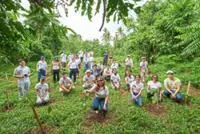WATER is our most precious natural resource, essential for sustaining life on Earth. We depend on water for everything, from food to clothing, business operations and so much more.
In nature, plants need water to survive and grow, whereas over 10% of all known animals and about 50% of all known fish species live in freshwater ecosystems – lakes, rivers, streams, wetlands and aquifers. Despite its critical role for people and nature, freshwater is a limited and finite resource. Of all the water on earth, just 3% is fresh water.





